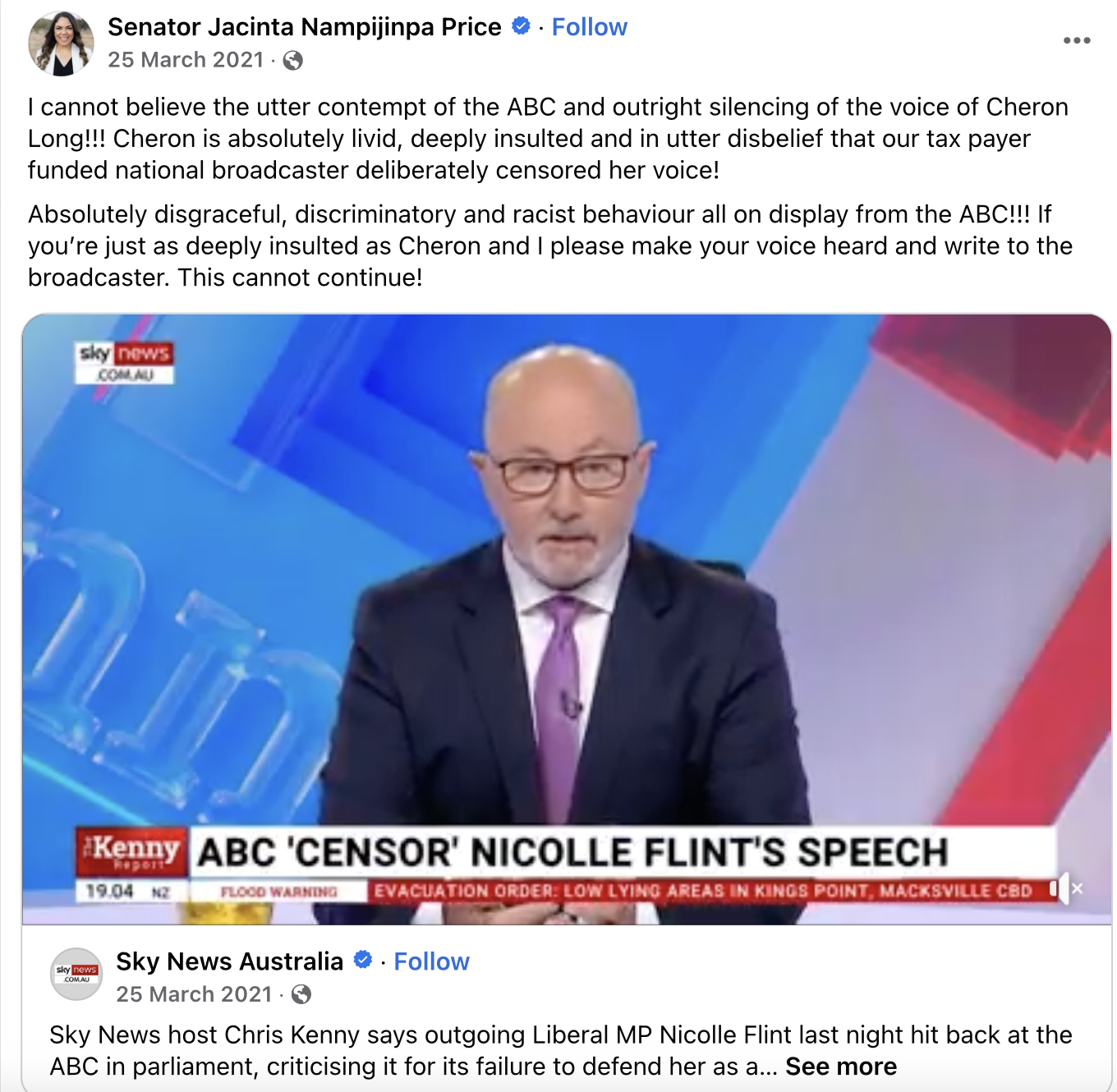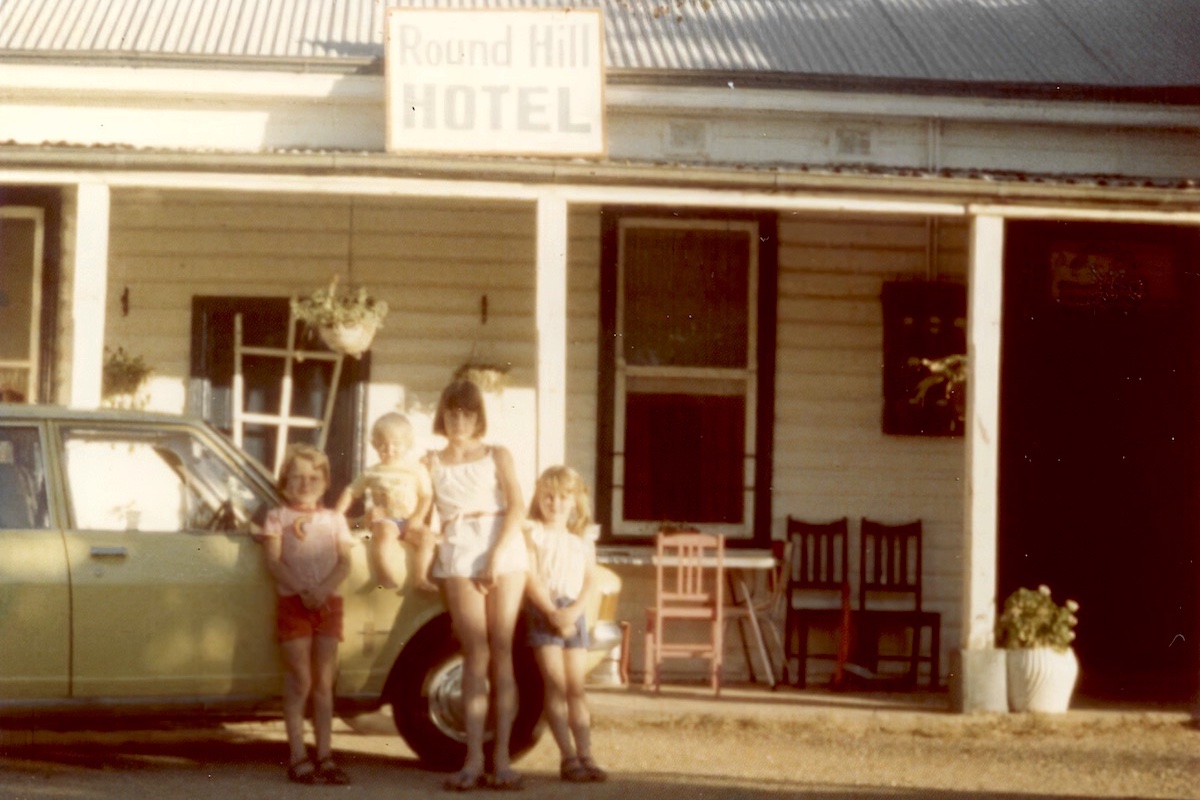Australia
Australian Indigenous Activists Call Out White Feminism's Deadly Blind Spot
The very language we now use to discuss social justice and feminism is being subjected to American critical-race ideology and intersectional feminism.

In March, three Indigenous women flew to Canberra in an attempt to draw attention to a horror story playing out in their communities. These were Alice Springs Deputy Mayor Jacinta Price, who heads up the Indigenous Research Program at the Centre for Independent Studies; and Cheron and Meesha Long, cousins of 15-year-old Layla Leering, who died in 2017 after apparently being sexually assaulted in the Northern Territory. Layla’s death—along with that of two other girls, Fionica Yarranganlagi James and Keturah Cheralyn Mamarika—has been the subject of a coroner’s inquest, and has brought renewed attention to the threat that Indigenous girls and women face within their own communities. Unfortunately, the scope of that attention has been limited, because the narrative of intra-Indigenous abuse is seen as unfashionable to report.

Since reporting my own story of childhood sexual assault, I’ve been closely attuned to the many other survivors who’ve shared their own. I’ve also observed how these stories are variously ignored or signal-boosted according to the political and cultural agenda of journalists and politicians—adding another layer of manipulation and cruelty to these women’s experiences. In the case of the Indigenous women who travelled to Canberra, the Australian Broadcasting Corporation (ABC) and other media were reportedly wary that the trio’s message might cast Indigenous men in a negative light. Liberal parliamentarian Nicolle Flint was so enraged by the national broadcaster’s failure to report properly on their visit that she made a point of reading parts of Cheron Long’s testimony to Parliament at a time when the session was being broadcast live on ABC radio, including the following:
We have to live with an Aboriginal rape culture. Sexual abuse is accepted as normal in too many Aboriginal communities. When I have been interviewed by the media, I have been told not to use these words because they demonise Aboriginal men. The media don’t want to hear the truth. But white feminists are allowed to say whatever they want. Why is it that Aboriginal women and children suffer the most, but they won’t let us have our own voice when it comes to violence and sexual abuse in this country? Why won’t they let us tell our story?
Amazingly, even as the ABC was being called out for silencing Indigenous women, the announcer abruptly cut the broadcast during Flint’s presentation.
In a court of law, “testimony” is a form of evidence. And in the social and political sphere, we are now accustomed to the idea that “lived experience” is the gold evidentiary standard when it comes to assessing the moral strength of social-justice causes. So what does it mean when a national broadcaster works to suppress reports of the “lived experience” of Australia’s Indigenous women—in the service of protecting its own ideological framework?
French sociologist Pierre Bourdieu explored the idea of cultural production as emerging from class-based, hierarchically mediated interaction within literary, artistic, and philosophical fields—through which incumbents insulate their power. “The consecrated writer is the one who has the power to consecrate and to win assent when he consecrates an author or a work,” Bourdieu wrote in 1993. At the time, he was referring to direct modes of affirmation and approval, such as “a preface, a favourable review, a prize, etc.” But his wider analysis extends to other forms of consecration exerted by means of cultural power.
I want to suggest that the “testimony” of women—especially in regard to their material reality—is being treated as a form of cultural product. It is “consecrated” or discarded by a field of cultural power. Unlike in a court of law, neither the truth of the testimony, nor the character of the author, are as important as the institutional and political power it reinforces.
Cheron Long’s testimony about the conditions surrounding her cousin’s death was based in fact. Following the inquest into the death of Leering, James, and Mamarika, Judge Greg Cavanagh concluded that “these children lived and died in conditions of violence, sexual molestation, and despair. That these conditions continue to exist in an affluent country such as Australia is a disgrace. These are similar conditions to that witnessed by me, and recorded in my findings into youth suicide deaths in 1991 and in relation to volatile substance abuse deaths in 2005.” All of the details are contained in his December 15th, 2020 report.
And yet a media search for the victims’ names brings up relatively scant coverage. Our screens instead have been filled with details surrounding Brittany Higgins, a young government employee who was allegedly raped in Australia’s Parliament building in 2019 by a government staffer. I don’t doubt her account for a minute, but I do take issue with the selective nature of the coverage.
Ms. Higgins’s accusations of sexual abuse—like most of the other accusations that have been prominently aired in regard to misconduct and rampant sexism among parliamentary lawmakers and staff—implicate either conservative parliamentarians, or the parliamentary policies that operate under the incumbent centre-right Liberal government. Putting aside accusations that these testimonies have been weaponized for political purposes, the editorial choices made by Australia’s media tell a deeper story about the way that issues related to sex and gender are now covered.

More from the author.
The very language we now use to discuss social justice and feminism is being subjected to American critical-race ideology and intersectional feminism. The testimonies of women are being tested against sanctified oppression narratives of racial and gender oppression. Certain intersectional feminists are sanctified because they will not speak against Indigenous men, who have been cast as victims in the wider oppression narrative surrounding colonization. All of this is connected to an ideological framework described as anti-racism, which often seems to simply be a framework for rebranding white saviours and noble savages.
At the recent March4Justice in Melbourne, anger was a dominant theme—specifically, anger at “sexism, misogyny, and dangerous workplace cultures,” according to a (male) journalist reporting on the event in the Sydney Morning Herald. Signs read, “The future is female and it is furious” and “No Swinging Dicks.” Women chanted “to hell with the patriarchy!” The furious tone of these slogans suggests that Australian women inhabit a deeply sexist society. But notwithstanding the (genuinely concerning) revelations about the professional climate for political staffers in Canberra, Australia scored better than any other nation in the world in a 2018 survey of women’s workforce equality. At the March4Justice event, one woman held up a sign that read, “Karens for Justice.” But in general, it isn’t the “Karens” who, are in most dire need of help, but the Laylas, Fionicas, and Keturahs—a constituency that few elites seem eager to talk about.
The prominence of issues emphasized by wealthy white women in power struggles against white wealthy men (such as what language we should be using, and the required level of female representation in executive suites) has caused many to dismiss popularized forms of intersectional feminism as “white feminism.” Grassroots feminists like me, on the other hand, direct our anger at other issues that the media isn’t talking about. We are angry at being told that self-defined gender, not biological sex, marks the proper domain of feminist concern; that our testimony will be heard only if expressed in the idiom of gender ideology; and that only one race of people can be critiqued in a progressive framework. As Cheron Long asserts, “white feminists,” despite all their performative disavowals of white supremacy, systematically guard their privileged access to media and political platforms from Indigenous women who deviate from the progressive script.
Scotland has become the testing ground for the implementation of this brand of sex-denying “white” feminism. Kirsty Blackman, a progressive Scottish Parliamentarian, recently tweeted in defence of the idea that anti-discrimination legislation should be based strictly on gender, not on sex. In response, women offered their unsanctified testimony of sex-based trauma and female genital mutilation. Blackman waved these testimonies away on the basis that such issues came under the purview of “abuse rather than discrimination,” which was “not really within the scope of the legislation” under discussion.
Is there research showing that discrimination happens on the basis of actual sex rather than perceived sex or gender? Because otherwise it seems that a lot of energy is being poured into arguing about solving a problem that doesn’t exist, at the expense of solving one that does.
— Kirsty Blackman (@KirstySNP) March 25, 2021
This specific Twitter exchange related to the composition of public boards, which itself is consistent with the privileged upper middle-class tenor that now dominates such discussions. Much time is also wasted applying intersectional analysis to the question of what type of women should be allowed to participate in Pride parades, convene speaking events at libraries, or receive literary prizes. But rape and female genital mutilation performed on a large scale by people who happen not to be white males is selectively ignored.
We should be collectively ashamed of ourselves for letting the discourse be shaped in this way. And by this, I don’t mean “ashamed” in the sense that Robin DiAngelo or Ibram X. Kendi might level such an accusation, but in the sense that we have betrayed those who suffer in their own homes and communities, and who continue to experience, as I once did, the light sleep of the hunted. Those of us who have unconsecrated testimonies must speak, and be allowed to be heard. Journalists at ABC and other outlets must remove their hand from the mouths of those whose stories they claim to honour most.
This will require that, among other things, we allow women to centre feminism around the issues we face, as we once did before a small cadre of media and activist elites turned the definition of “woman” into a cultural hologram, and demanded that we pledge obeisance to moral hierarchies imported from American race politics.
Judge Cavanagh said that the most unsettling aspect of the inquest into the three girls’ deaths “has been the blindness of the government agencies to the obvious trauma suffered by these girls.” For her part, Cheron Long has returned to the Northern Territory after her trip to Canberra, reportedly “livid, deeply insulted and in utter disbelief” at the treatment she received. Yet I have no trouble believing it. The suppression of her testimony is the working of a cultural system that sanctifies speech associated with one particular ideology, and a feminism that ignores the needs of many of the most vulnerable female people.






